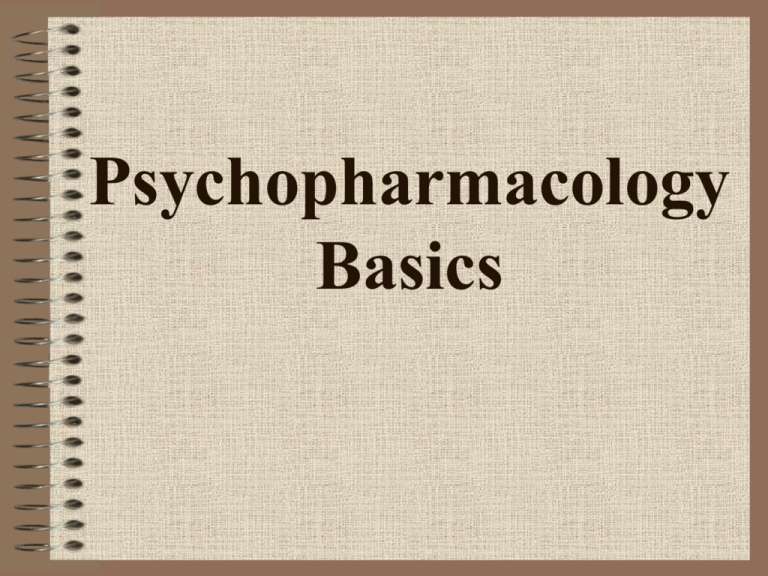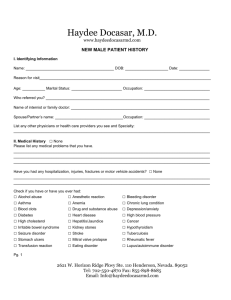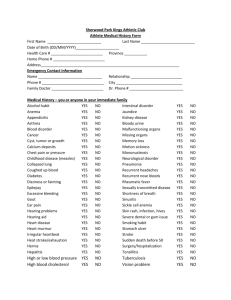PY 440 Psychopharmacology Basics
advertisement

Psychopharmacology Basics An important aspect of treatment of emotional disorders is with psychotherapeutic medications. Compared to other types of treatment, these medications are relative newcomers in the fight against mental illness. People who, years ago, might have spent many years in mental hospitals because of crippling mental illness may now only go in for brief treatment, or might receive all their treatment at an outpatient clinic. Symptom Relief, Not Cure Just as aspirin can reduce a fever without clearing up the infection that causes it, psychotherapeutic medications act by controlling symptoms. Like most drugs used in medicine, they correct or compensate for some malfunction in the body. Psychotherapeutic medications do not cure mental illness, but they do lessen its burden. Like any medication, psychotherapeutic medications do not produce the same effect in everyone. Some people may respond better to one medication than another. Some may need larger dosages than others do. Pharmacology offers hope to many who would otherwise have a dismal prognosis. Pharmacology: Study of Drugs • Drug: any substance that when administered to a living organism • Produces a change in function • Water, metals (iron) or insecticidies can be classified as drugs • In common usage, the term DRUG refers to any medication used to treat disease. Pharmacology Divisions • Pharmacodynamics: study of drugs on living tissue • Pharmacotherpeutics: study of use of drugs in treating disease • Posology: study of the amount of drug required to produce therapeutic effects • Pharmacy: science of preparing and dispensing medications • Toxicology: study of harmful effects of drugs of living tissue Clinical Psychopharmacology – concerned mainly with the use of drugs to treat abnormal human behavior. Where do drugs come from? • Plants • Animals • Synthetic: produced in labs What actually is a drug? • A chemical compound with a specific chemical structure • Receptor site: specific area on a cell membrane where drug attaches self. Binding = drug action. • Agonists: produces drug action • Antagonists: blocks drug action No drug produces only ONE effect • Intended (or therapeutic) effect along with several other effects • Side effects • Side effects generally not harmful unless TOXIC Drug Safety • The federal • FOOD and DRUG ADMINISTRATION FDA • has established guidelines governing the approval and use of all drugs • Public safety is priority • Every drug must fill two requirements before used in humans: –Must be effective in the disease state for which approved –Must not produce toxic effects at therapeutic doses What is a clinical trial? • A clinical trial is a research study to answer specific questions about vaccines or new therapies or new ways of using known treatments. • Clinical trials (also called medical research and research studies) are used to determine whether new drugs or treatments are both safe and effective. • Carefully conducted clinical trials are the fastest and safest way to find treatments that work. • Ideas for clinical trials usually come from researchers. • Once researchers test new therapies or procedures in the laboratory and get promising results, they begin planning Phase I clinical trials. • New therapies are tested on people only after laboratory and animal studies show promising results What is a protocol? • All clinical trials are based on a set of rules called a protocol. • A protocol describes what types of people may participate in the trial; the schedule of tests, procedures, medications,and dosages; and the length of the study. • While in a clinical trial,participants are seen regularly by the research staff to monitor their health and to determine the safety and effectiveness of their treatment What are clinical trial phases? • Clinical trials of experimental drugs proceed through four phases: • In Phase I clinical trials, researchers test a new drug or treatment in a small group of people (20-80) for the first time to evaluate its safety, determine a safe dosage range, and identify side effects. • In Phase II clinical trials, the study drug or treatment is given to a larger group of people (100-300) to see if it is effective and to further evaluate its safety. • In Phase III studies, the study drug or treatment is given to large groups of people (1,000-3,000) to confirm its effectiveness, monitor side effects, compare it to commonly used treatments, and collect information that will allow the drug or treatment to be used safely. • Phase IV studies are done after the drug or treatment has been marketed. These studies continue testing the study drug or treatment to collect information about their effect in various populations and any side effects associated with long-term use. What is a control or control group? • A control is the standard by which experimental observations are evaluated. • In many clinical trials, one group of patients will be given an experimental drug or treatment,while the control group is given either a standard treatment for the illness or a placebo. What is a placebo? • A placebo is an inactive pill, liquid, or powder that has no treatment value. • In clinical trials, experimental treatments are often compared with placebos to assess the treatment's effectiveness. • In some studies, the participants in the control group will receive a placebo instead of an active drug or treatment What is a blinded or masked study? • A blinded or masked study is one in which participants do not know whether they are in the experimental or control group in a research study. • Those in the experimental group get the medications or treatments being tested, while those in the control group get a standard treatment or no treatment What is a double-blind or doublemasked study? • Neither the participants nor the study staff • know which participants are receiving the experimental treatment • and which ones are getting either a standard treatment or a placebo. • These studies are performed so neither the patients' nor the doctors' expectations • about the experimental drug can influence the outcome. Safety…. • Before approved for humans, drugs must undergo several years of animal (several species) testing and evaluation • LD50: Lethal dose 50, dose that would kill 50% of animals tested • Therapeutic Index: TI is ratio of ED50 and LD50 of a drug TI = LD50 = 1000mg ED50 = 10 100mg Used only in animal studies to establish dosage levels for other testing procedures Generic Drugs • Manufacturing medications is expensive – Clinical trials process – Marketing • Patent expires • Produced with less restriction • Usually less expensive • Effectiveness?????? Basic Concepts of Pharmacology • Site of action: location within the body where the drug exerts its therapeutic effect. • Mechanism of action: explains how the drug produces its effects Biological Concepts • Most drugs in psychopharmacology affect humans by affecting the communication between neurons in the brain. • To understand these effects, you must understand something about cell membranes, • and the special protein structures in membranes that regulate the flow of substances and information in and out of the cell. • Then you can understand how this regulation can result in an electrical signal which travels down the neuron • and how this electrical signal can be transferred between neurons at synapses, • where neurotransmitters are released from one cell • to affect receptors on another cell. Biological Concepts Most drugs in psychopharmacology work by affecting the communication between neurons in the brain. The brain is made of cells (called neurons) which communicate with each other at places called synapses. A synapse is a functional (but not physical) contact between two neurons. Neuron Neuron Synapse Half Life Effect Time • Neurotransmitters: about 40 known or suspected neurotransmitters in the brain. The following chemicals have been shown to act as neurotransmitters in the brain: Dopamine Norepinepherine Serotonin Acetylcholine Gamma aminobutyric acid (GABA) Several Amino Acids Acetylcholine Two types of receptors-nicotinic receptors and muscarinic receptors. Nicotinic receptors are on muscle fibers; both types exist in the central nervous system. Found in the brain (mostly excitatory), spinal cord, ganglia of the autonomic nervous system (mostly excitatory) and at the target organs of the parasympathetic branch of the autonomic nervous system (both excitatory and inhibitory). Death of acetylcholine neurons is the primary cause of Alzheimer's Disease. • Epinephrine (adrenaline) Drugs that block the activity of dopaminergic Synthesized by the adrenal glands. • Adrenal is Latin for "toward kidney" and epi nephron is Greek for "upon the kidney." • Dopamine Implicated in movement, attention neurons alleviate psychotic symptoms, leading to speculation that schizophrenia is caused by dopaminergic overactivity. • Cocaine and amphetamine work at dopaminergic synapses to increase activity, and prolonged or excessive exposure to amphetamine or cocaine can result in acute psychosis. • Norepinephrine Most noradrinergic synapses in the CNS. • At the target organs of the sympathetic nervous system, norepinephrine produces EPSPs. • Serotonin Plays a role in the regulation of mood, in the control of eating, sleep and arousal, and in the regulation of pain. • Drugs which inhibit serotonin increase dreaming and can cause hallucinations (LSD). Anti-depressants…….. • can be roughly categorized into groups, depending upon their chemical structure and the way they work • 1) tricyclics and tetracyclics (TCA's); • 2) monoamine oxidase inhibitors (MAOI's); • 3) serotonin-specific reuptake inhibitors (SSRI's); • miscellaneous. Commonly Rx Tetracyclics/Tricyclics • amitriptyline (Elavil, Endep, Enden, Tryptizol) amitriptyline + (perphenazine, Etrafon, Triavil) amoxapine (Asendin) clomipramine (Anafranil) desipramine (Norpramine, Pertofrane) doxepin (Adapin, Sinequan) imipramine (Tofranil, Janimine) maprotiline (Ludiomil) nortriptyline (Pamelor, Ventyl, Aventyl) protriptyline HCL (Vivactil) trimipramine (Surmontil) • Serotonin-specific Reuptake Inhibitors (SSRI's) • These drugs, along with the tricyclic and tetracyclic drugs and the MAOI's, are considered the major antidepressant drugs; • they are also effective in a wide range of disorders, including bipolar I disorder, dysthymic disorder, eating disorders, panic disorder, obsessive-compulsive disorder, and borderline personality disorder. • Because they generally have fewer adverse side effects than other classes of antidepressants they are more widely prescribed; • one SSRI, fluoxetine (Prozac), the least cardiotoxic of all antidepressants, has become the most widely prescribed antidepressant and is one of the top ten most prescribed drugs in the US. Commonly RX SSRI’s • fluoxetine (Prozac) fluvoxamine (Luvox) paroxetine (Paxil) sertraline (Zoloft) (Serzone) (Celexa) ANTIANXIETY MEDICATIONS • Formerly called the "minor tranquilizers", the medicines in this group are primarily used in the treatment of anxiety; • they are also used for some other disorders, such as depression, panic disorder, social phobia, bipolar I disorder, and substance withdrawal. • Because they have a higher therapeutic index and less abuse potential, the benzodiazepines • (which comprise the largest number in this group) have largely replaced the barbituates in treatment for these disorders, and are also widely used a s sedatives and hypnotics as well as anesthetics, anticonvulsants, and muscle relaxants. • Antihistimines are occasionally used to treat anxiety disorders, as are the beta-blockers. Commonly Rx Antianxiety • Alprazolam (Xanax) Atenolol (Tenormin) buspirone (BuSpar) chlordiazepoxide (Librium, Libritabs, Lipoxide) clonazepam (Klonopin) clonodine (Catapres) ANTIPSYCHOTIC MEDICATIONS • This group, formerly known as the "major tranquilizers", or neuroleptics, is comprised mainly of a set of drugs known as dopamine-blockers, • These drugs target the idiopathic psychoses that have no known cause, such as schizophrenia, schizophreniform disorder, schizoaffective disorder, delusional disorder……………. • brief psychotic disorder, manic episodes, and major depressive disorder with psychotic features, • as well as being commonly used in the treatment of patients who are severely agitated and violent. • They have a wide application for a variety of disorders, including movement disorders, anxiety disorders, and psychoses that have organic causes. • Commonly RX Antipsychotic • chlorpromazine fluphenazine haloperidol loxapine mesoridazine perphenazine pimozide risperidone thioridazine thiothixene trifluoperazine (Thorazine,) (Prolixin, ) (Haldol) (Loxitane) (Serentil) (Trilafon) (Orap) (Risperdal) (Mellaril) (Navane) (Stelazine) Side Effects • Potent drugs usually have potent side effects, and the antipsychotic drugs are no exception!!! ANTIMANIC MEDICATIONS • Many of the drugs that have already been discussed have been found to be efficacious in effecting mood regulation or stabilization, such as the benzodiazepines, carbamazepine, clozapine, the dopamine receptor antagonists, lithium, L-tryptophan, and valproate. Commonly Rx Antimanics • diltiazem (Cardizem) nifedipine (Adalat, Procardia) nimodipine (Nimotop) verapamil (Calan, Isoptin) lithium carbonate (Cibalith-S, Camcolt, Priadel, Liskonum, Phasal-these are not used in US) SEDATIVES AND HYPNOTIC MEDICATIONS • This class includes the barbituates, which are among the first drugs to be used in clinical psychiatric treatment, being introduced in the US in 1903. • One of the oldest sedative-hypnotic drugs still in use, chloral hydrate, has been used since 1869. • Because of their high abuse potential and lower therapeutic index, the barbituates are now less commonly prescribed than the newer compounds, such as the benzodiazepines and buspirone, which are considered much safer. Side Effects • A high abuse potential is associated with these drugs, the barbituates in particular. • Drowsiness, confusion, constipation, blurred vision, edema, vertigo, paradoxical dysphoria, hyperactivity, cognitive disorganization, lethargy, fatigue, headache. • Many of the adverse side effects are similar to those of the benzodiazepines Commonly Rx Sedatives/Hypnotics • Amobarbital aprobarbital butabarbital chloral hydrate ethchlorvynol methohexital nitrazepam pentobarbital phenobarbital secobarbital zolpidem (Amytal) (Alurate) (Butisol) (Noctec) (Placidyl) (Brevital) (Mogadon) (Nembutal) (Luminal, Barbita, Solfoton) (Seconal) (Ambien) MEDICATION USED TO OFFSET THE SIDE EFFECTS OF OTHER MEDICATIONS • This rather inclusive group encompasses the anti-parkinsonsism, anticonvulsant, anticholinergic, sideeffect medicines which target the neuroleptic-induced movement disorders, such as……….. • parkinsonism, malignant syndrome, acute dystonia, acute akathisia, tardive dyskinesia, postural tremor and various other movement disorders that are • extrapyramidal side effects (EPS). Side Effects • Oddly enough, medicines that target side-effects can themselves have sideeffects, such as • hypotension and bradycardia, nausea, • vomiting, diarrhea, and constipation • anticholinergic effects, abuse potential, dizziness, insominia, irritability, depression, anxiety, nausea, Commonly Rx • Anticholinergics and Amantadine • amantadine (Symmetrel, Symadine) benztropine mesylate (Cogentin) biperidin (Akineton) ethopropazine (Parsidol) procyclidine (Kemadrin) trihexyphenidyl (Artane, Tremin, Trihexane, Trihexy-5) • Beta-Adrenergic Drugs • (Beta-blockers) • atenolol chlorthalidone metoprolol nadolol propranolol (Tenormin) (Tenoretic) (Lopressor) (Corgard) (Inderal) • Antihistamines • cyproheptadine diphenhydramine Cough, Hydramine, Phendry, Twilite) bromocriptine Dantrolene (Periactin) (AllerMax, Banophen, Belix, Benadryl, Dephen Dormarex-2, Genahist, Nidryl, Nordryl, Nytol, Sleep-Eze-3, Sominex 2, (Parlodel) Psychostimulants • MEDICATIONS USED FOR ATTENTION DEFICIT DISORDER • This category is devoted almost exclusively to the amelioration of attentiondeficit/hyperactivity disorder (ADHD) effects. • It includes the sympathomimetics, clonidine, and some of the tricyclic antidepressants. Commonly Rx Psychostimulants • amphetamine (Benzedrine) clonidine hydro-chloride (Catapres) desipramine HCL (Norpramin, Pertofrane) dextroamphetamine (Dexedrine) imipramine HCL (Tofranil, Janimine) methylphenidate (Ritalin) pemoline (Cylert) (Adderall) (Concerta)







